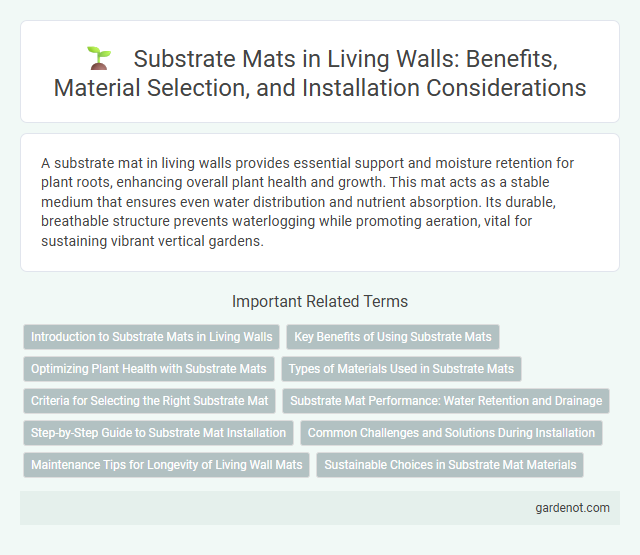A substrate mat in living walls provides essential support and moisture retention for plant roots, enhancing overall plant health and growth. This mat acts as a stable medium that ensures even water distribution and nutrient absorption. Its durable, breathable structure prevents waterlogging while promoting aeration, vital for sustaining vibrant vertical gardens.
Introduction to Substrate Mats in Living Walls
Substrate mats serve as a vital growing medium in living walls, providing essential support, water retention, and nutrient distribution for plants. These mats are designed with synthetic fibers or natural materials that promote root development while ensuring efficient drainage to prevent waterlogging. Integrating substrate mats enhances plant health and longevity, making them crucial for sustainable vertical gardening systems.
Key Benefits of Using Substrate Mats
Substrate mats provide optimal moisture retention and efficient drainage, promoting healthy root growth in living walls. Their lightweight and flexible composition allows easy installation on vertical surfaces while preventing waterlogging and root rot. By improving aeration and nutrient distribution, substrate mats enhance plant health and overall longevity of green wall systems.
Optimizing Plant Health with Substrate Mats
Substrate mats play a crucial role in optimizing plant health within living walls by providing consistent moisture retention and improved aeration to root systems. These mats enhance nutrient absorption efficiency, reducing water wastage and promoting robust plant growth. Integrating high-quality substrate mats supports sustainable irrigation practices while preventing root diseases in vertical garden installations.
Types of Materials Used in Substrate Mats
Substrate mats in living walls typically use materials such as coconut coir, felt, and synthetic fibers, each providing optimal water retention and root support. Coconut coir is favored for its natural biodegradability and excellent moisture retention, while felt compositions offer durability and efficient air circulation. Synthetic fibers like polyester blends are engineered for longevity and resistance to mold, enhancing the overall health and stability of vertical gardens.
Criteria for Selecting the Right Substrate Mat
Selecting the right substrate mat for a living wall requires prioritizing water retention capacity, drainage efficiency, and nutrient delivery to support plant health. Material durability and resistance to mold or decay should be evaluated to ensure long-term structural integrity and plant vitality. Compatibility with plant species and ease of installation also play crucial roles in optimizing living wall performance and maintenance.
Substrate Mat Performance: Water Retention and Drainage
Substrate mats in living walls are engineered to optimize water retention while ensuring efficient drainage, preventing root waterlogging and promoting healthy plant growth. High-performance substrate mats balance moisture holding capacity with rapid excess water evacuation, creating an ideal microenvironment for plant roots. The mat's porosity and material composition directly influence its water retention properties, making it crucial for maintaining sustained hydration and aeration in vertical garden systems.
Step-by-Step Guide to Substrate Mat Installation
Begin substrate mat installation by securely attaching the mat to the wall using corrosion-resistant fasteners, ensuring full surface coverage for optimal plant growth. Overlap the edges of adjacent mats by at least 2 inches to prevent gaps and maintain structural integrity. Press the mat firmly against the wall to promote heat and moisture retention, creating an ideal environment for root establishment.
Common Challenges and Solutions During Installation
Substrate mat installation in living walls often faces challenges such as uneven surface adhesion and water retention issues, which can lead to poor plant growth and structural instability. Ensuring precise surface preparation and selecting mats with optimal water retention and drainage properties address these problems effectively. Incorporating specialized fastening systems improves mat stability and longevity, supporting healthy plant development in vertical garden systems.
Maintenance Tips for Longevity of Living Wall Mats
Regularly inspect the substrate mat for moisture levels to prevent mold growth and root rot, ensuring proper drainage and aeration. Use a balanced, slow-release fertilizer embedded in the mat to maintain nutrient availability without oversaturation. Promptly remove dead plant material and debris from the mat surface to reduce the risk of fungal infections and extend the living wall's lifespan.
Sustainable Choices in Substrate Mat Materials
Sustainable choices in substrate mat materials for living walls prioritize biodegradable, renewable, and recycled components such as coconut coir, peat alternatives, and recycled polyester. These eco-friendly substrates enhance water retention while minimizing environmental impact and supporting plant health. Selecting sustainable mats contributes to reducing carbon footprints and promoting circular economy practices in vertical gardening.
Substrate mat Infographic

 gardenot.com
gardenot.com